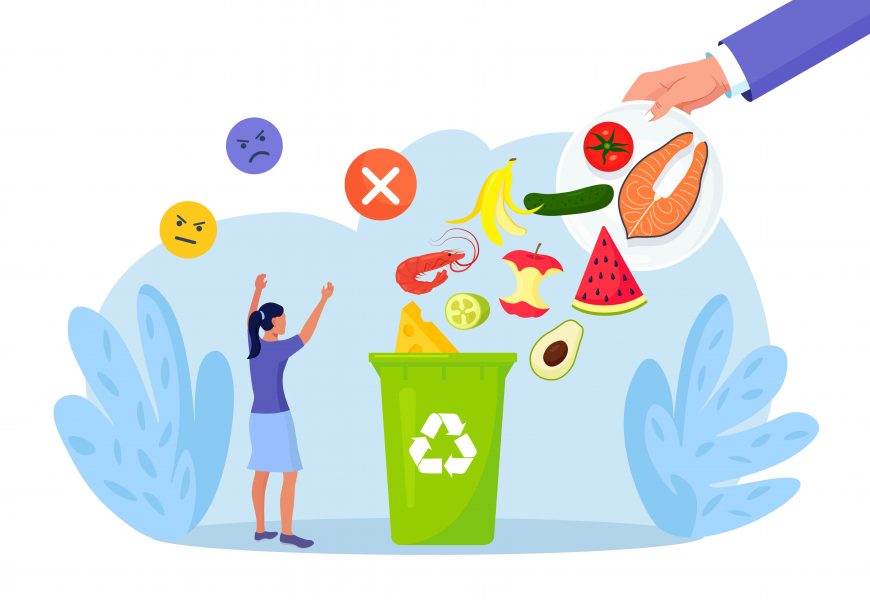What’s more important than finding 10 ways to avoid the wastage of food? That’s an essential thing while managing a kitchen, as food waste contributes in some or other ways to environmental damage and unnecessary expenses in our daily lives. Each year, lots of edible food ends up in landfills and for waste because of poor planning, improper storage, and non-awareness. By making all the small changes in our day-to-day kitchen habits, we can surely reduce waste, save money, and contribute to a more sustainable food system. Steps that are simple, like smart shopping, proper food storage, and creative meal planning, can make a big impact in reducing waste and maximizing resources.
> In this article, you’ll discover practical strategies on how to control food wastage, improve kitchen waste management, and adopt better food waste management practices. We are going to explore various useful ways to store food for longer periods, utilize the leftovers with creativity, and practice portion control to prevent the extra waste of food. Along with that, we will cover sustainability habits like donating the extra food, using the natural vegetables for composting and supporting local food production sources, all of which will have the same aim of helping you reduce food waste while creating an eco-friendly environment.
>Contents
Sustainability in the Kitchen: 10 ways to avoid wastage of food ………………………………………………. 1
10 Ways to Avoid Wastage of Food………………………………………………………………………………… 1
1. Plan Your Meals and Shop Smart ……………………………………………………………………….. 2
2. Store Food Properly to Extend Freshness …………………………………………………………….. 2
3. Get Creative with Leftovers ………………………………………………………………………………. 2
4. Practice Portion Control While Cooking ……………………………………………………………….. 2
5. Use Every Part of Ingredients (Root-to-Stem Cooking) …………………………………………….. 3
6. Freeze and Preserve Excess Food ……………………………………………………………………….. 3
7. Compost Organic Waste for a Greener Kitchen ……………………………………………………… 3
8. Donate Excess Food to Those in Need …………………………………………………………………. 3
9. Support Local & Sustainable Food Sources …………………………………………………………… 4
10. Understand Expiry Dates and Use-By Labels ……………………………………………………… 4
Conclusion……………………………………………………………………………………………………………….. 4
10 Ways to Avoid Wastage of Food
Food waste is a growing concern, affecting both our environment and personal finances. 10 ways to avoid wastage of food include simple yet effective steps that can help you minimize waste, save money, and promote sustainability. Whether you want to learn how to stop food waste or adopt
better kitchen waste management practices, this guide will provide practical solutions to make your kitchen more efficient and eco-friendly.
By following these methods, you’ll understand how to control food wastage while improving meal planning, storage techniques, and overall food consumption habits. These small efforts collectively contribute to food waste management, ensuring a greener future for everyone.
1. Plan Your Meals and Shop Smart
One of the easiest ways to reduce food waste is to plan your meals in advance. Many people buy more than they need, leading to spoilage and unnecessary waste.
- Make a weekly meal plan to determine what ingredients are necessary.
- Check your pantry and refrigerator before shopping to avoid duplicates.
- Stick to a grocery list to resist impulse purchases.
- Buy fresh produce in smaller quantities to ensure they are used before spoiling.
By implementing meal planning, you take control of your purchases, reducing waste and improving kitchen waste management.
2. Store Food Properly to Extend Freshness
Food storage plays a crucial role in how to control food wastage. Many items go bad simply because they aren’t stored correctly.
- Keep fruits and vegetables in breathable bags to prevent moisture buildup
- Store perishable foods like dairy and meat in the coldest part of the fridge.
- Use airtight containers for grains, nuts, and dry foods to prevent infestation.
- Label leftovers with dates to track their freshness.
Proper storage techniques not only extend the shelf life of food but also contribute to better food waste management.
3. Get Creative with Leftovers
Instead of throwing away extra food, turn leftovers into delicious new meals. This is an excellent strategy for how to stop food waste while maximizing ingredients.
- Transform last night’s roast vegetables into a soup.
- Use cooked rice for stir-fried rice or burrito fillings.
- Blend overripe bananas into smoothies or bake them into muffins.
- Make homemade croutons from stale bread.
A little creativity in the kitchen ensures that every ingredient gets used
efficiently.
4. Practice Portion Control While Cooking
Cooking excessive amounts of food often leads to leftovers that go uneaten. How to reduce food waste starts with being mindful of portion sizes.
- Use measuring cups and food scales to cook the right quantity.
- Serve smaller portions and allow second helpings if needed.
- Teach family members to take only what they can finish. Reducing portion sizes
prevents waste and ensures a more balanced diet.
5. Use Every Part of Ingredients (Root-to-Stem Cooking)
One of the most effective ways to reduce food waste is to utilize every part of an ingredient. This method called root-to-stem cooking, ensures nothing goes to waste.
- Use vegetable peels, stalks, and stems for homemade broths.
- Roast carrot tops, beet greens, and radish leaves instead of discarding them.
- Use citrus peels to make zest, infused water, or homemade cleaners.
- Save bones and seafood shells for making flavorful stock.
By practicing root-to-stem cooking, you minimize waste while maximizing nutrition.
6. Freeze and Preserve Excess Food
If you have excess food that you can’t consume immediately, freezing is an excellent way to store it for later.
- Freeze fruits, vegetables, and meats to extend their shelf life.
- Store fresh herbs in oil or butter and freeze them into cubes for easy use.
- Preserve seasonal produce by pickling, fermenting, or drying.
- Divide large meals into smaller portions and freeze them for later consumption.
Using the freezer effectively is a great kitchen waste management strategy that helps you save food for future use.
7. Compost Organic Waste for a Greener Kitchen
Despite our best efforts, some food waste is inevitable. Instead of sending it to landfills, composting is a great way to repurpose organic scraps.
- Convert fruit peels, vegetable scraps, coffee grounds, and eggshells into nutrient-
rich compost. - Use compost to enrich garden soil and grow fresh produce.
- Avoid composting dairy, meat, or oily foods, as they attract pests.
Composting is an essential part of sustainable food waste management that benefits both your kitchen and the environment.
8. Donate Excess Food to Those in Need
Many communities and food banks accept donations of surplus food to help those who are less fortunate. If you have extra non-perishable food, consider donating it instead of letting it go to waste.
- Partner with local food banks, shelters, or community kitchens.
- Organize food donation drives within your community.
- Ensure donated food is safe, unexpired, and properly stored.
Donating food not only reduces waste but also helps those in need, making it an impactful way to stop food waste.
9. Support Local & Sustainable Food Sources
Where you buy your food also influences how to reduce food waste. Choosing local and sustainable food sources supports eco-friendly farming and ensures fresher produce.
- Buy from local farmers’ markets to get fresher, long-lasting produce.
- Opt for seasonal fruits and vegetables, as they have a longer shelf life.
- Reduce reliance on packaged and processed foods that contribute to waste.
By supporting sustainable food sources, you contribute to responsible food waste management.
10. Understand Expiry Dates and Use-by Labels
A significant portion of food waste occurs because of confusion over expiration dates. Understanding how these labels work can help reduce unnecessary waste.
- “Best Before” dates indicate quality, not safety—foods are often still good
after this date. - “Use By” dates are important for perishable items and should be followed
strictly. - Smell and inspect food before discarding it—trust your senses.
- Organize your pantry and fridge using the First In, First Out (FIFO) method to
use older items first.
By learning how to read food labels, you can significantly control food wastage and make better use of groceries.
Conclusion
Reducing food waste starts with small, mindful steps in our daily routines. By following these 10 ways to avoid wastage of food, such as meal planning, proper storage, portion control, and composting, you can make a significant difference in food waste management. Simple habits like using leftovers creatively, supporting sustainable food sources, and donating excess food can help you control food wastage while benefiting the environment and your budget.
Understanding how to stop food waste is essential for a more sustainable future. Whether through better kitchen waste management or learning how to reduce food waste, every effort counts. Start implementing these strategies today and make your kitchen a place of efficiency and responsibility!



















